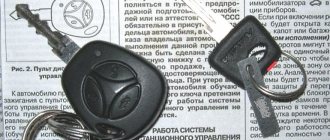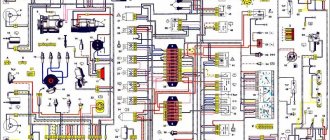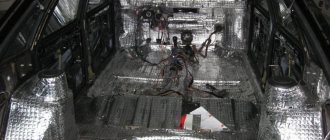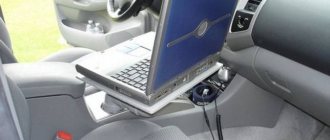On some LADA cars, the sound of the direction indicators is quiet or absent altogether. For this reason, drivers may forget to turn off their turn signals in a timely manner. On other models it is possible to change the tone of the sound of the turn signals, but few people know about this, because There are no instructions in the car's owner's manual. We'll tell you everything in order.
Sound doubler for direction indicator - diagram
Nowadays, modern cars are equipped with direction indicators that automatically return to their original position when the maneuver is completed.
But this does not apply to all models, and there is no need to talk about budget and old cars. We have all seen moving vehicles on the roads with their turn signals on, when the driver simply forgot to turn them off.
This especially affects novice car enthusiasts. This will greatly disorient other road users and may lead to an emergency.
The sound of the turn signal - a sound backup - will help you avoid such an unpleasant situation. The circuit and design of such a device will be discussed in today’s article.
The device circuit is very simple. The idea is to connect a miniature board to the car's dashboard indicator lamps (+U1 and +U2). Essentially, when the turn signals are turned on, power supply is simply applied to the circuit.
The circuit itself is two generators connected in series. Each time the indicator is turned on, the circuit plays several intermittent sound signals. The number of beeps each time the pointer is turned on, as well as their tone, can be configured.
So, we have two generators DD1.1, DD1.2 - the number of sound signals when the indicator is lit and DD1.3, DD1.4 - the tone of the reproduced sound vibrations. The first generator controls the start of the second, i.e. the generator on DD1.3, DD1.4 works only when the first one works.
The frequency with which the generators operate is determined by the parameters of their RC circuits: R1C1 and R2C2. This is what setting up the circuit is all about. By selecting capacitor C1 you can regulate the number of sound vibrations, and by selecting C2 you can regulate their fundamental tone.
Almost any buzzer (piezo emitter) designed for a voltage of 12 V without a built-in generator can be used. For example, such as HCM1212A or HCM1612A.
Printed circuit board (link) - single-sided for installing SMD components. DD1 chip in SO-14 package, resistors and capacitors in 1206 packages. You can use any diodes of suitable size, for example, DL4148.
Contact pads: +U1 and +U2 - connection to the pointer indicator lights, GND - ground, BZ1 - connection to the piezo emitter.
I know that many people do not like surface mounting or are simply “unfriendly” with it. This is also not a problem. In general, everything can be done by hanging installation, the main thing is that there is somewhere to place it all later. The DD1 microcircuit is replaceable with our K561LA7 with the same pinout, the resistors are ordinary MLT, and the capacitors are K10-17.
Source
Firmware for Granta, Kalina shield
On the Lada Granta and Lada Kalina family of cars, the lack of sound for direction indicators and hazard warning lights is not a defect. The presence of turn signal and hazard warning lights in the instrument cluster depends on the software version. This is indicated in the AvtoVAZ information letter.
READ How to properly connect a VAZ 21099 radio
That is, in order for the sound of the turn signals to appear, you need to flash the dashboard to the required software version.
Making a car craft - making an audible turn signal for your “Swallow”
Sometimes drivers, especially beginners, forget to turn off the turn signal after completing a maneuver. The standard clicks are sometimes not audible if the music is playing loudly. An audible 12 v turn signal, made by yourself, will help correct the situation. Instructions for making your own tweeter are included in this article.
We install and change the sound of turn signals on LADA cars
On some LADA cars, the sound of the direction indicators is quiet or absent altogether. For this reason, drivers may forget to turn off their turn signals in a timely manner. On other models it is possible to change the tone of the sound of the turn signals, but few people know about this, because There are no instructions in the car's owner's manual. We'll tell you everything in order.
Purpose of the sound turn signal repeater
In cars, as a rule, turn signal switches began to be installed, which automatically return to the neutral position after completing the maneuver. This has its advantages: there is no need to be distracted by turning off the turn signals when the turn is completed, and there is no need to waste time checking whether the signal is turned off. Over time, the auto-return switch may fail (video author: Alexander Baranov).
On some vehicles, the switch does not automatically return to its original position. In this case, you must independently ensure that it turns off after completing the turn. When you turn on the turn signals, clicks are heard, but sometimes you can’t hear them due to loud music or noise.
If you do not turn off your turn signals in time, this may cause an emergency on the road, as it confuses other road users.
By installing an audible warning of the switch relay operation, you can solve the problem of forgetting to turn off the turns.
Communities › Electronic Crafts › Blog › Help me choose the sound of the turn relay
I appeal to the collective mind! I made a version of a regular three-pin turn signal relay to work with LEDs. With adjustable threshold and indication of burnt out lamps. On a smart key. Don't ask why I'm reinventing the wheel, etc. etc. To sound, you need to select the most suitable buzzer sound. Please watch the video with sound, not for personal gain. The very first buzzer is the best, KMK, but it is impossible to buy it in small quantities. That leaves three options available. I bought a dozen different ones to try, and more or less only three of them fit. We need the opinion of a large number of people on which buzzer to choose
Instructions for making a beeper for turn signals
You can make an audible turn signal for your car with your own hands within 15 minutes, without contacting a car service about it. To create such a duplicate turn signal, you will need a K561LN2 microcircuit; it will serve as the basis. In addition, you need a buzzer, but without a built-in generator.
Universal audio repeater
You can take a buzzer that has a built-in generator if you like its sound. In this case, we look at an example of connecting a buzzer to a standard low-frequency generator. Having connected to the bass generator, you should turn the tuning knob and select the most suitable sound. Now you can reproduce it using the K561LN2 microcircuit and a generator as a basis.
Tweeter connection diagram
The device diagram can be represented in two parts:
The tone of the audio repeater is adjusted by changing the value of C1 and R1. When connecting the device, the negative pole is attached to the vehicle ground, and the positive pole is taken from the emergency stop button through “decoupling” diodes.
To determine the button terminals, you should use a multimeter. On it you need to select the mode for measuring DC voltage. After turning on the left turn signal, you need to look at which terminal the +12 Volt voltage periodically appears. Similar actions must be performed by turning on the right turn signal.
Assembled audio device
In this case, the device is mounted mounted. For the housing of the sound turn signal, a 2 mm syringe with a piston removed from it is used. The wire comes out of a narrow hole - the nose of the syringe, and the buzzer is attached to the back of the syringe using hot-melt adhesive.
Thus, it is easy to assemble an audio turn signal repeater with your own hands using a microcircuit and 5 logic elements. At the same time, you can save time and money on visiting a car service center.
Guide to making a 12v audio turn signal with your own hands
Sometimes drivers, especially beginners, forget to turn off the turn signal after completing a maneuver. The standard clicks are sometimes not audible if the music is playing loudly. An audible 12 v turn signal, made by yourself, will help correct the situation. Instructions for making your own tweeter are included in this article.
Purpose of the sound turn signal repeater
In cars, as a rule, turn signal switches began to be installed, which automatically return to the neutral position after completing the maneuver. This has its advantages: there is no need to be distracted by turning off the turn signals when the turn is completed, and there is no need to waste time checking whether the signal is turned off. Over time, the auto-return switch may fail (video author: Alexander Baranov).
On some vehicles, the switch does not automatically return to its original position. In this case, you must independently ensure that it turns off after completing the turn. When you turn on the turn signals, clicks are heard, but sometimes you can’t hear them due to loud music or noise.
If you do not turn off your turn signals in time, this may cause an emergency on the road, as it confuses other road users.
By installing an audible warning of the switch relay operation, you can solve the problem of forgetting to turn off the turns.
Instructions for making a beeper for turn signals
You can make an audible turn signal for your car with your own hands within 15 minutes, without contacting a car service about it. To create such a duplicate turn signal, you will need a K561LN2 microcircuit; it will serve as the basis. In addition, you need a buzzer, but without a built-in generator.
You can take a buzzer that has a built-in generator if you like its sound. In this case, we look at an example of connecting a buzzer to a standard low-frequency generator. Having connected to the bass generator, you should turn the tuning knob and select the most suitable sound. Now you can reproduce it using the K561LN2 microcircuit and a generator as a basis.
Tweeter connection diagram
The device diagram can be represented in two parts:
The tone of the audio repeater is adjusted by changing the value of C1 and R1. When connecting the device, the negative pole is attached to the vehicle ground, and the positive pole is taken from the emergency stop button through “decoupling” diodes.
To determine the button terminals, you should use a multimeter. On it you need to select the mode for measuring DC voltage. After turning on the left turn signal, you need to look at which terminal the +12 Volt voltage periodically appears. Similar actions must be performed by turning on the right turn signal.
Assembled audio device
In this case, the device is mounted mounted. For the housing of the sound turn signal, a 2 mm syringe with a piston removed from it is used. The wire comes out of a narrow hole - the nose of the syringe, and the buzzer is attached to the back of the syringe using hot-melt adhesive.
Thus, it is easy to assemble an audio turn signal repeater with your own hands using a microcircuit and 5 logic elements. At the same time, you can save time and money on visiting a car service center.
Video “Installing a sound duplicate of turn signals”
This video demonstrates how to install an audible turn signal signal yourself (the author of the video is Auto-Moto World).
Homemade sound duplicator of turns on the K561ln2 chip
I’ll tell you right away why I didn’t use a regular buzzer with a built-in generator - I didn’t like the sound tone. Therefore, I first connected the buzzer to an existing low-frequency generator, turned the knob, chose the most pleasant sound and reproduced it using the generator on the k561ln2 chip.
The entire turn signal repeater circuit can be divided into 2 parts:
Frequency adjustment (adjusting the sound tone of the turn signal repeater) is done by changing the value of R1 and C1.
Installation and connection of the turn signal circuit to the on-board network.
The “-” circuit is connected to the vehicle ground, and the “+” is supplied through “decoupling” diodes from the emergency stop button. To determine which terminals of the button to connect to, take a multimeter, set it to DC voltage measurement mode, turn on the left turn - find at which terminal + 12V cyclically appears and disappears, do the same with the left turn turned on.
In my case, the circuit was assembled using the surface-mounted method. As a housing for the sound duplicator of turns, a 2-ml syringe was chosen from which the piston was removed. The wire was taken out of the spout hole, and the buzzer was glued with hot glue to the pad on the opposite side. As you can see, in 10 minutes you can make your own sound duplicator of turns using a logic chip and a pair of attachments
Samodelkin
I live in the World of DIY, I post articles sent by readers. Sometimes I write on topics: useful homemade products for the home and homemade products for radio amateurs.
New homemade products by Samodelkin (See all)
Installing a buzzer
If it is not possible to flash the instrument panel, or the instrument cluster is not included in the list from the document, it is possible to install the buzzer yourself (buy).
Installation and connection
The buzzer can also be connected to the hazard warning button block (photo author):
Result on video:
Homemade product that duplicates the operation of car turn signals
We collect as follows:
We check the resistance of the resistor, as shown in the photo.
We also check the capacitors and telephone capsule.
We check the functionality of the homemade product by connecting + 12V power to it from the power supply or car battery. The generated signal must be audible in the telephone capsule. Delivery of new homemade products to the post office
Receive a selection of new homemade products by email. No spam, only useful ideas!
*By filling out the form you agree to the processing of personal data
Become the author of the site, publish your own articles, descriptions of homemade products and pay for the text. Read more here.
DIY turn signal, diagram – Crafts for cars
Drivers often forget to turn off their turn signals. Therefore, I propose to assemble and place an additional signal there that will be heard and inform you that the turn signal is working. The device circuit is based on a generator built on the K561LE5 microcircuit.
Characteristics of K561LE5:
3P-3 was used as a piezo sound emitter, but analogues are also suitable. Using a variable resistor, we adjust the volume and tone of the signal; in my case, the volume resonance was set to maximum.
Audio signal generator circuit
List of radio components
The board size is approximately 20x22mm. We place the board with the piezo emitter into the housing. We connect the power wires parallel to the wires coming from the relay connector (turn signal breaker).
And so, carefully pull the terminals out of the connector, wind the wires, insulate them and put the terminals back in their place. Also, turn on the turn signal and use the trimmer to adjust the volume and tone of the sound. The signal can also be clearly heard against the background of loud music in the car.
Similar articles:
Simple audible indicator for turn signals
Most modern cars are equipped with turn signal switches that, when backing out, are automatically turned to the neutral position by the steering wheel.
Unfortunately, this mechanism, used on domestic cars, is far from perfect, and after only a year of using the car it fails. Repair is complicated by the fact that it is necessary to remove the steering wheel and replace the unit with steering column switches.
Therefore, most car enthusiasts continue to drive a car with such a minor malfunction. Meanwhile, the habit of not turning off the turn signals after performing a maneuver remains for a long time. In order not to mislead others, you can supplement the light indicator of the turn signals, which is located on the dashboard of any car, with a low-volume audible alarm. In amateur radio literature, descriptions of such devices are common, but they are all relatively complex, containing several transistors or a microcircuit.
In this regard, I think that the circuit of a simple sound doubler for a car signal light, all done on one dual-base transistor, may be of interest. The diagram is shown in the figure.
This is a simple pulse generator based on a double-base transistor. The frequency of the pulses that the generator produces depends on the parameters of the circuit R2 C1, and the sound volume depends on the resistor R1. As a sound emitter, you can use any dynamic or electromagnetic emitter with a voice coil resistance of 8.40 Ohms, for example, a speaker from a pocket receiver, or a capsule from a telephone.
Such a signaling device, but with a different sound tone, can also be connected, for example, to an oil pressure warning lamp in the engine system, or a brake fluid level monitoring lamp. Other applications of such a sound generator that are not related to the car are also possible.
The generator supply voltage can be within 3.30 V, and the sound volume changes accordingly.
Similar materials
Sound homemade turn duplicator | Everything-easy.ru
Sound homemade turn duplicator
I’ll tell you right away why I didn’t use a regular buzzer with a built-in generator - I didn’t like the sound tone. Therefore, I first connected the buzzer to an existing low-frequency generator, turned the knob, chose the most pleasant sound and reproduced it using the generator on the k561ln2 chip.
The entire turn signal repeater circuit can be divided into 2 parts:
Frequency adjustment (adjusting the sound tone of the turn signal repeater) is done by changing the value of R1 and C1.
Installation and connection of the turn signal circuit to the on-board network.
The “-” circuit is connected to the vehicle ground, and the “+” is supplied through “decoupling” diodes from the emergency stop button. To determine which terminals of the button to connect to, take a multimeter, set it to DC voltage measurement mode, turn on the left turn - find at which terminal + 12V cyclically appears and disappears, do the same with the left turn turned on.
In my case, the circuit was assembled using the surface-mounted method. As a housing for the sound duplicator of turns, a 2-ml syringe was chosen from which the piston was removed. The wire was taken out of the spout hole, and the buzzer was glued with hot glue to the pad on the opposite side. As you can see, in 10 minutes you can make your own sound duplicator of turns using a logic chip and a pair of attachments
Source
Communities › VAZ: Repair and Improvement › Blog › Tweeter as a turn signal indicator
After complete soundproofing of the body, the turn signal relay became absolutely inaudible, as it clicked. Unfortunately, due to the adapter for the steering wheel, my turn signals do not snap off. To make an indication, I decided to install a beeper like in a foreign car. It connects to the emergency button, everything is as easy as shelling pears. The ground wire is connected to the black wire of the hazard warning button connector; I personally have the + contact connected to the blue wire of the connector (or by pointing to the + from the connector).
Comments 64
By the way, you have one drawn on the diagram, but in the photo it is soldered to another, then the question is, what is the point of the diodes, you just need to remove them and leave the resistor and conductor, that’s how you have it soldered in the photo s50.radikal.ru/i130/ 1506/b6/74362e8c68c6.jpg
Damn, I thought I deleted the photo. I made 4 pieces for friends and took a photo of the one left. and I saw her with a joint later
In general, I soldered this tweeter, with exactly the same parts, and it doesn’t work, even if I connect it permanently to the battery, it manages to squeak in a quarter of a second and goes silent)
This means the capacitor is not being discharged, send me a photo in a personal message
But why so many unnecessary parts, connect a tweeter in parallel to the lamp and that’s it, or does the tweeter have a different sound with such a circuit?
As you suggest, it will blink in time with the lamp, but as I suggest, it will be 2 times more often and, due to the capacitor, the sound will be damped, and not just a squeak
Vehicle horns
Door opening alarm. This device is a simple multivibrator assembled from simple and affordable elements. It produces an intermittent sound signal (frequency approximately 2 kHz) with a repetition rate of approximately 4 Hz. If the doors or trunk are opened, the BF1 piezo emitter installed in the cabin under the rear seat emits an intermittent sound signal, which informs the driver that one of the doors is not closed or the trunk is not closed. To be fair, it is worth noting that foreign cars have long been using similar systems with a quiet and melodic sound.
The device does not require adjustment, and if the elements are in working order, it starts working immediately. It is connected parallel to the interior lighting lamps. The polarity of the connection does not matter, since the circuit contains a diode bridge (VD1...VD4). When the doors (hood, trunk) are opened, the light in the car interior comes on and power is supplied to the multivibrator. The circuit is operational in the voltage range from 5 to 15 V, which is quite consistent with the on-board network. By changing (within small limits) the values of the chains C1-R2 and C2-R4, you can change the period and frequency of the sound signal.
Reverse warning light. The author uses the described circuit with a slight modification to send a loud signal through the BA1 speaker when the car is moving in reverse. In this case, the circuit and dynamic head are compactly placed in the trunk near the rear panel. It is convenient to use a suitable soap dish as a housing for this circuit. The sound from the speaker is loud enough to attract the attention of passers-by to a car moving in reverse at a distance of up to 20 m.
Turn signal. This circuit beeps when the turn signals are turned on. Often (especially on older car models) the driver forgets to turn off the turn signal after completing the maneuver, which leads to a tense situation on the road for other road users.
In this circuit, the BF1 emitter will signal that the turn signal is on. A simple audio frequency generator is assembled on two elements DD1.1 and DD1.2 of the DD1 microcircuit. Pin 7 of the DD1 chip is connected to the ground of the car. Points “a” and “b” of the diagram are connected to the wires of the turn switch in the steering column housing. You need to look for them empirically or using the electrical diagram of the car. The resistance of the BF1 emitter winding must be at least 1600 Ohms so as not to create an excessive load on the output of the DD1.2 logic element. The circuit and emitter are located under the dashboard of the car.
Source











